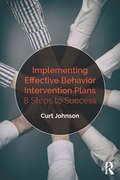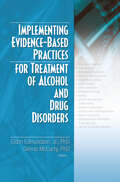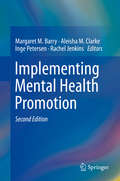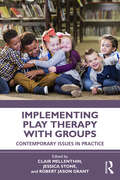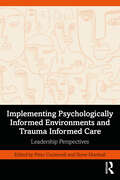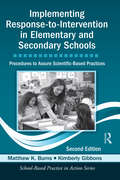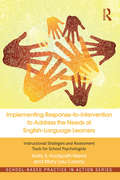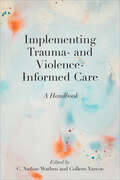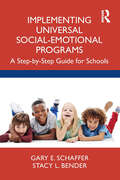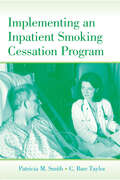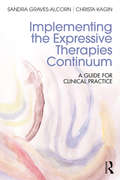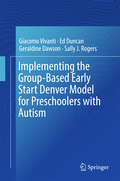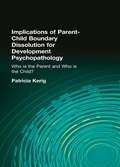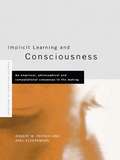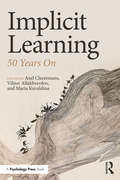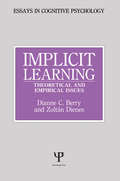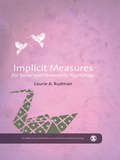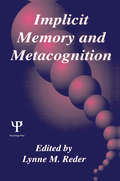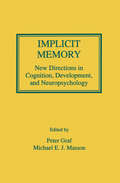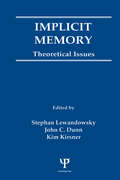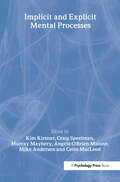- Table View
- List View
Implausible Beliefs: In the Bible, Astrology, and UFOs
by Allan MazurWhy do people accept ideas that are contradicted by science or logic? In Implausible Beliefs, Allan Mazur offers a comparative look at the nature of irrational belief systems, their social roots, and their cultural and political impact. He begins by providing standards for judging beliefs implausible and assessing the impact of such belief systems onpolitics and social policy in the US. Mazur describes and defends commonsense criteria for establishing that certain views should not be sustained in the face of present-day understanding. He presents a statistical portrait of implausible beliefs rampant in the US, and who tends to accept them.Mazur applies criteria for implausibility to the Bible, astrology, and visitation to Earth of intelligent beings from other worlds. Pointing out that everyone "knows" the Bible but few actually read it, the author scrolls through the first five books of the text, noting points that undermine the scripture's natural history and moral guidance. Working on the assumption that implausible religious views are fundamentally no different from implausible secular views, he critiques secular beliefs in astrology and UFOs. Mazur concludes the volume with an attempt to explain why most people accept implausibility‘some more than others despite evidence and logic that refute them.Looking to mainstream sociology and psychology, Mazur shows how children are socialized into such beliefs, and how adults are influenced by spouses and friends. Personality is also a factor, sometimes abetted by stressful or lonely life situations. Lucidly written, this is a provocative and informative contribution to social psychology, sociology, religion, political science, and American studies.
Implementation Fidelity in Education Research: Designer and Evaluator Considerations
by Coby Meyers W. Christopher BrandtImplementation science is an important and underrepresented topic in the literature of educational research, despite the fact that it is inextricably tied to education policy and improvement. Implementation fidelity (the degree to which a program or intervention is delivered as planned) is, in particular, a key issue for every program developer and researcher designing, executing, interpreting, or communicating their work. Implementation Fidelity in Education Research provides the first serious developer-evaluator collaborative perspective on the practical considerations of implementation fidelity in program development. Using case studies from Investing in Innovation (i3) fund grants, this book prepares future researchers for the challenges posed by implementation issues both ideologically and in practice. This book will be an excellent resource for anyone interested in education research and evaluation and an excellent supplement to research methods courses.
Implementing Classwide PBIS: A Guide to Supporting Teachers (The Guilford Practical Intervention in the Schools Series)
by Jennifer Freeman Diane Myers Brandi SimonsenFilling a vital need, this is the first comprehensive guide to supporting K–12 teachers in effective implementation of classwide positive behavioral interventions and supports (CWPBIS). The book presents a roadmap for designing and delivering professional development based on behavioral principles. Procedures are outlined for providing data-driven CWPBIS training and coaching that is responsive to the needs of each teacher. User-friendly features include illustrative case studies, learning questions and exercises at the end of each chapter, and reproducible training tools. The large-size format and lay-flat binding facilitate photocopying; purchasers also get access to a Web page where they can download and print the reproducible materials. See also the authors' related teacher/practitioner resource: Classwide Positive Behavior Interventions and Supports: A Guide to Proactive Classroom Management. This book is in The Guilford Practical Intervention in the Schools Series, edited by Sandra M. Chafouleas.
Implementing Effective Behavior Intervention Plans: 8 Steps to Success
by Curt JohnsonWhether written by a school psychologist, BCBA, or skilled practitioner of any variety, all behavior intervention plans face the same difficulty—the writer and implementer are not the same person. Too frequently, successful BIPs are discounted and discarded by those responsible for implementation. Many BIPs are simply filed, rather than followed. Without additional burden to time-constrained professionals, this book addresses how to effectively and efficiently increase implementation fidelity. Using a systems analysis approach to school climate, interwoven with ample case studies, school psychologists will be guided through eleven chapters of a step-by-step process to effectively create and implement behavior intervention plans.
Implementing Evidence-Based Practices for Treatment of Alcohol And Drug Disorders
by Jr. Eldon Edmundson Dennis McCarty"Implementing Evidence-Based Practices for Treatment of Alcohol and Drug Disorders" provides managers and clinicians with results from Practice Improvement Collaboratives (PIC) that demonstrate how substance abuse treatment can be improved by increasing the exchange of knowledge between community-based service providers and the research community. The book examines improvement collaboratives and mentoring strategies for adopting and using evidence-based practices. Contributors address how to determine the best treatment processes to serve clients, how to deal with the hurdles faced in preparing and training counsellors, and how to affect the needed changes in agency activities. This unique professional resource responds to an Institute of Medicine report that found a substantial disconnect between research and practice in treatment for drug and alcohol dependence. Focusing on how to make the changes necessary to support the adoption and use of evidence-based practices, the book documents the activities of four sites to illustrate how investigators and treatment practitioners worked together to implement evidence-based practices. Contributors examine the development and early implementation of Practice Improvement Collaboratives, the investigator-provider-policymaker model, Motivational Enhancement Therapy, the use of Opinion Leaders in training, and targeted strategies that take into account the differences in clinician demographics and training. "Implementing Evidence-Based Practices for Treatment of Alcohol and Drug Disorders" is an essential tool for alcohol and drug counsellors, directors of alcohol and drug treatment clinics, and instructors in counsellor training and academic programs.
Implementing Mental Health Promotion
by Margaret M. Barry Aleisha M. Clarke Inge Petersen Rachel JenkinsThis book offers a comprehensive overview of current research, policy, and practice developments in promoting mental health and well-being. It offers guidance on developing and delivering mental health promotion interventions across a variety of settings internationally. Chapters outline key mental health promotion concepts, implementation processes, and outcomes through empirical findings, practical advice based on successful evidence-based approaches, and templates for action. In addition, chapters answer key “how” questions on practical implementation as well as the “whys”, providing rationales for mental health promotion and identifying the key factors and underlying principles that make these interventions work. The book includes examples of evidence-based practice with 17 case studies of innovative interventions from different international settings. These case studies illustrate the practical aspects of intervention development and delivery and the realities of implementing policies and programes outside of controlled research conditions. Topics featured in this book include: · Interventions that promote gender equality. · Community empowerment models of mental health promotion. · Mental health promotion in the home for children and parents. · Promoting social and emotional learning in schools. · Addressing stress and promoting mentally healthy workplaces. · Mental health promotion within primary health care. · Re-orienting mental health services to mental health promotion for service users and caregivers. Implementing Mental Health Promotion, Second Edition, is a must-have resource for researchers, clinicians and related professionals, and policymakers as well as graduate students across such interrelated disciplines as health promotion, public health, child and school psychology, social work, clinical psychology, child and adolescent psychiatry, health psychology, educational policy and practice, school nursing, occupational therapy, school counseling, and family studies.
Implementing Play Therapy with Groups: Contemporary Issues in Practice
by Clair MellenthinImplementing Play Therapy with Groups is a new and innovative edited book bringing together experts from across the field of play therapy to explore how to facilitate group play therapy across challenging settings, diagnoses, and practice environments. Applying theoretical and empirical information to address treatment challenges, each chapter focuses on a specific treatment issue and explores ways the reader can implement group work within their play therapy work. Chapters also provide contemporary evidence-based clinical information in providing group therapy with specific populations such as working with children who have been exposed to violence, trauma, adoption, foster care, those who are chronically medically fragile, and more. This book will bring awareness to, and provide easily implemented play therapy knowledge and interventions for, child and family therapists who work in a range of settings including schools, hospitals, residential treatment centers, and community mental health settings.
Implementing Psychologically Informed Environments and Trauma Informed Care: Leadership Perspectives
by Peter Cockersell Sione MarshallThis book gathers together the experiences of leaders across sectors, organisations and client groups to help readers introduce, develop, and maintain psychologically informed environments (PIE) and trauma informed care (TIC) within their workspaces.Featuring the voices of providers, commissioners, consultants, and trainers from the NHS, local authorities, and the voluntary sector, this unique text includes chapters on implementing PIE across a range of overlapping fields, including young people’s, homelessness, mental health, and women’s services. Each chapter describes the contributors’ experiences of which factors and processes enable or disable successful implementation of PIE/TIC; the unique challenges of leadership within this process; and how to understand the different dynamics at play in an organisation that determine effectiveness. With an emphasis on practical examples underpinned by theory, and recommendations drawn from the emergent themes, the book acts as an invitation for leaders to explore how they can influence the growth and evolving shape of PIE and trauma informed approaches across health and social care and support settings, and beyond.This book will be an invaluable resource for aspiring and new, as well as experienced, leaders who are interested in implementing and enabling PIE and TIC in their organisations.
Implementing Response-to-Intervention in Elementary and Secondary Schools: Procedures to Assure Scientific-Based Practices, Second Edition (School-Based Practice in Action)
by Matthew K. Burns Kimberly GibbonsAn update to the bestselling first edition, this practical guidebook for implementing a school-wide Response-to-Intervention (RTI) model clearly and concisely presents issues from assessment and decision-making to Tiers I, II, and III interventions. The authors discuss what RTI is and why it is used, how to conduct assessments within an RtI system, and how to create a school-wide organization to facilitate RTI. Curricula, instruction, and intervention strategies for each Tier level covered in detail, and answers to frequently asked questions and tips for getting started are also provided. Each chapter has been extensively revised and updated with the most current research and work in the field. New to this edition are a chapter on RTI in early childhood settings and a section in each chapter focused on considerations for secondary schools. A companion CD includes forms, checklists, reports, and progress monitoring materials to assist practitioners in the implementation of interventions. With this valuable, practical resource, school-based practitioners will be able to put the information they read into action immediately to enhance the implementation of RtI services for their schools and students.
Implementing Response-to-Intervention to Address the Needs of English-Language Learners: Instructional Strategies and Assessment Tools for School Psychologists (School-Based Practice in Action)
by Holly S. Hudspath-Niemi Mary Lou ConroyThere is considerable concern surrounding the complex issue of how to meet the learning needs of English-language learners within general and special education programs. Implementing Response-to-Intervention to Address the Needs of English-Language Learners increases school psychologists’ knowledge of intervention strategies related to ELLs, through its examination of the challenges associated with evaluating ELLs and by providing a collaborative framework to enhance educational identification and placement in special education. It accomplishes this by incorporating research-based intervention approaches for ELLs and offering a comprehensive guide to the processes and tools that school teams should consider when utilizing a response to intervention model to support the academic and behavioral needs of ELLs. With a strong focus on alternative assessment, collaboration, and parental involvement, this volume in a definitive touchstone in the quest to provide culturally responsive pedagogy and appropriate adapted classroom instruction for English-language learners of various proficiency levels.
Implementing Transference-Focused Psychotherapy Principles: General Psychiatric Care for Personality Disorders
by Richard G. Hersh Chiara De PanfilisThis book focuses on the practical utility of key precepts of Transference-Focused Psychotherapy (TFP) in contemporary psychiatry. This volume actively addresses the pressing public health crisis related to high numbers of patients with personality disorder pathology, often with significantly compromised functioning associated with marked social burdens related to health costs and lost productivity. TFP is one of the empirically validated treatments for patients with borderline personality disorder (BPD). Building on this evidence base, the contributors to this volume describe their work in multiple clinical situations utilizing these principles with varying patient populations in different treatment settings. These settings include: the adult and adolescent day hospital, short term and extended inpatient hospitalizations, group therapy, and a range of outpatient services. Each chapter follows a consistent format to cover patient population, nature of treatment setting, overview of financial support, training of clinicians, treatment targets, elements of TFP employed, measurement of effectiveness, case study examples, and future research goals. Contributors from different backgrounds describe active use of TFP principles in their work, with adjustments from standard TFP protocol made accordingly. Implementing Transference-Focused Psychotherapy Principles builds on the growing literature about TFP by expanding the focus beyond the extended individual psychotherapy format. The text will resonate with psychiatrists, psychologists, social workers, and mental health counselors, among others. Clinicians involved in public health systems will find the material outlined of particular value in our evolving world of mental health services.
Implementing Trauma- and Violence-Informed Care: A Handbook
by Colleen Varcoe C. Nadine WathenThe need for health and social services to be trauma- and violence-informed has never been so pressing. In the wake of COVID-19, racial violence intensified and violence against women spiked globally. Mental health for many is worsening, while the ongoing toxic drug overdose crisis provides horrendous evidence of the impact of trauma, violence, stigma, and social inequities. Service providers across sectors are increasingly impacted by these dynamics and, without supportive environments, are burning out. Implementing Trauma- and Violence-Informed Care aims to support health and social service organizations and providers to create environments, policies, and practices to mitigate the harms of structural and interpersonal violence and the trauma that ensues. The book is organized around case examples of trauma- and violence-informed care (TVIC) implementation and impact in diverse settings, providing how-to guidance for getting started, sustaining momentum, and assessing outcomes. The book describes the importance of TVIC at multiple levels, from individual practices to organizational protocols and system-level policies, emphasizing TVIC’s alignment with system transformation goals. In doing so, the book presents TVIC as a call to action to improve service user experiences and outcomes, efficient and effective use of resources, and the health and well-being of staff, while addressing and reducing health and social inequities.
Implementing Universal Social-Emotional Programs: A Step-by-Step Guide for Schools
by Gary E. Schaffer Stacy L. BenderImplementing Universal Social-Emotional Programs is a step-by-step guide for school-based mental health professionals seeking to effectively select, employ, and evaluate universal social-emotional programs using implementation science. With one out of five children having diagnosable mental health challenges and many more of our youth developing social-emotional concerns, today’s schools must be able to effectively plan and implement evidence-based programs that promote social-emotional learning and positive academic outcomes. This book accompanies practitioners and graduate students in teaching, school psychology, counseling, social work, education, and administration through each stage of implementation science, common programs and screeners, the purpose and selection process of implementation teams, and schools’ expectations for fidelity, timeline, and budget. Throughout, the authors provide graphic organizers, diagrams, activities, exercises, vignettes, checklists, templates, charts, and other interactive features for active engagement.
Implementing an Inpatient Smoking Cessation Program
by Patricia M. Smith C. Barr TaylorImplementing an Inpatient Smoking Cessation Program serves as a step-by-step manual for implementing a cost-effective tobacco cessation program for hospitalized patients. Based on the Staying Free program, which has evidenced among the highest cessation rates reported in the scientific literature, this book is the result of decades of research by the authors. Although the book reviews a tobacco cessation program, the process is applicable to most behavioral interventions in acute- or long-term care settings.The book details the administrative responsibilities involved in designing, implementing, delivering, evaluating, and maintaining an inpatient tobacco cessation program. Its how-to approach focuses on the skills needed to: determine the work that needs to be done, select the appropriate interventions and providers, pay for and market the program, and create systems to keep the program alive. It provides algorithms for forecasting program enrollment and information on how to budget the program. Readers can then use this information as a blueprint for implementing their own program. A chapter on workflow provides a "virtual tour" of what to expect from the first 48 hours through the first year. Written in an accessible style with insightful interviews with actual providers, Implementing an Inpatient Smoking Cessation Program:*summarizes the literature on tobacco use, including the causal health effects and cost-effectiveness of cessation programs, to help readers build a case for a program;*reviews the clinical guidelines and advantages that support an inpatient program; and*provides tips on how to develop an effective program including insight into where the bottlenecks are likely to occur, and how to avoid them. Implementing an Inpatient Smoking Cessation Program is intended for health care administrators, providers, researchers, educators, and students in health care administration, public health, community and health psychology, (behavioral) medicine, nursing, respiratory therapy, and rehabilitation.
Implementing the Expressive Therapies Continuum: A Guide for Clinical Practice
by Sandra Graves-Alcorn Christa KaginImplementing the Expressive Therapies Continuum aims to explore the use of the Expressive Therapies Continuum (ETC) in the form of specific expressive therapy initiatives intended to be used in both educational and professional settings. Drawing on materials co-developed by Dr. Sandra Graves-Alcorn, co-author and developer of the ETC, as well as tried and tested curriculum by Professor Christa Kagin, this interdisciplinary resource will be of great value to students, teachers, mental health clinicians, as well as other healthcare practitioners interested in utilizing the ETC developmental model. All of this is delivered in a clear and easy to follow presentation designed to engage readers.
Implementing the Group-Based Early Start Denver Model for Preschoolers with Autism
by Geraldine Dawson Sally J. Rogers Giacomo Vivanti Ed DuncanThis book examines a group-based adaptation of the Early Start Denver Model (ESDM) designed for use with preschoolers with autism spectrum disorder (ASD). It describes the principles and procedures of the Group-Based Early Start Denver Model (G-ESDM) and provides practical and empirical guidelines for implementing effective, affordable programs across public healthcare and educational settings. Chapters offer rationales and strategies for designing and evaluating interventions, building interdisciplinary teams, and organizing learning spaces to engage student interest. Examples discuss the social interactions in groups that provide opportunities for learning, improving interpersonal skills, and reducing problem behaviors. In addition, the book offers ideas for retooling teaching strategies when an individual child lags behind the rest of the group. Featured topics include: Creating treatment objectives in the G-ESDM. Setting up the G-ESDM team and learning environment. Development of the G-ESDM classroom curriculum. Practical tools such as decision-making trees, teaching templates, and fidelity systems. Facilitating learning through peer interactions and social participation. Implementing the Group-Based Early Start Denver Model for Preschoolers with Autism is a must-have resource for clinicians and practitioners as well as researchers, professors, and graduate students in the fields of child and school psychology, behavioral therapy, and social work along with psychiatry, pediatrics, and educational and healthcare policy.
Implications of Parent-Child Boundary Dissolution for Developmental Psychopathology: "Who Is the Parent and Who Is the Child?"
by Patricia K. KerigGain a better understanding of parent-child boundaries and the mechanisms for their dissolutionThe breakdown of appropriate generational boundaries between parent and child can threaten the child&’s psychological development. Implications of Parent-Child Boundary Dissolution for Developmental Psychopathology: Who Is the Parent and Who Is the Child? explores this covert and oftentimes ignored form of emotional abuse, discussing in detail the various ways it can manifest. This revealing text comprehensively examines how the burden of meeting the emotional needs of the parent interferes with the child&’s healthy development. The boundary dissolution patterns of role reversal, enmeshment, psychological control, and triangulation are closely examined with an eye toward providing appropriate strategies for dealing with the problem.Implications of Parent-Child Boundary Dissolution for Developmental Psychopathology is separated into four sections to focus extensively on every aspect of the problem. The first section discusses definitions, concepts, and methodological concerns of the phenomena, including a consideration of the child&’s developmental responses to boundary dissolution. The second section explores the empirical research concerning boundary dissolution within the family system, and includes intriguing information on the actual mechanism that passes the pattern of role reversal on to the following generation. The next section closely examines boundary violations within high-risk families, with a focus on those undergoing divorce. The final section concentrates on cultural contexts of boundary dissolution and includes a look at the perception of familial responsibility and its effects on Bosnian youths. This one-of-a-kind resource is extensively referenced, and provides a solid foundation to inspire a new generation of theory, research, and clinical work.Implications of Parent-Child Boundary Dissolution for Developmental Psychopathology examines: a multidimensional model of boundary dissolution-with supporting research a comprehensive review of published literature in the areas of attachment theory, developmental capacities of the infant, child-rearing practices, and parental beliefs the theoretical background supporting the construct of boundary dissolution the boundary disturbance patterns of enmeshment and control the relationships between interparental conflict, parental responses to children&’s emotions, and representations of role reversal and vulnerability in children&’s family drawings the &’spill over&’ effect of marital conflict role reversal in high-risk families children&’s rejection of one parent over another in custody disputes post-war adjustment of Bosnian adolescents psychological control in individualist and collectivist groups representations of parents and children in twentieth century American novelsImplications of Parent-Child Boundary Dissolution for Developmental Psychopathology is crucial reading for researchers and clinicians who deal with families and psychopathology and is of particular interest to graduate students in clinical child psychology, child and family studies, social work, and developmental psychology.
Implicit Learning and Consciousness: An Empirical, Philosophical and Computational Consensus in the Making (Frontiers of Cognitive Science)
by Axel Cleeremans Robert M. FrenchCan you learn without knowing it? This controversial and much debated question forms the basis of this collection of essays as the authors discuss whether the measurable changes in behaviour that result from learning can ever remain entirely unconscious. Three issues central to the topic of implicit learning are raised. Firstly, the extent to which learning can be unconscious, and therefore implicit, is considered. Secondly, theories are developed regarding the nature of knowledge acquired in implicit learning situations. Finally, the idea that there are two separable independent processing systems in the brain, for implicit and explicit learning, is considered.Implicit Learning and Consciousness challenges conventional wisdom and presents the most up-to-date studies to define, quantify and test the predictions of the main models of implicit learning. The chapters include a variety of research from computer modelling, experimental psychology and neural imaging to the clinical data resulting from work with amnesics. The result is a topical book that provides an overview of the debate on implicit learning, and the various philosophical, psychological and neurological frameworks in which it can be placed. It will be of interest to undergraduates, postgraduates and the philosophical, psychological and modeling research community.
Implicit Learning: 50 Years On
by Axel Cleeremans Viktor Allakhverdov Maria KuvaldinaCan we learn without knowing we are learning? To what extent is our behavior influenced by things we fail to perceive? What is the relationship between conscious and unconscious cognition? Implicit Learning: 50 Years On tackles these key questions, fifty years after the publication of Arthur Reber’s seminal text. Providing an overview of recent developments in the field, the volume considers questions about the computational foundations of learning, alongside phenomena including conditioning, memory formation and consolidation, associative learning, cognitive development, and language learning. Featuring contributions from international researchers, the book uniquely integrates ‘Western’ thinking on implicit learning with insights from a rich Russian research tradition. This approach offers an excellent opportunity to contrast perspectives, to introduce new experimental paradigms, and to contribute to ongoing debates about the very nature of implicit learning. Implicit Learning: 50 Years On is essential reading for students and researchers of consciousness, specifically those interested in implicit learning.
Implicit Learning: Theoretical and Empirical Issues (Essays in Cognitive Psychology)
by Zoltan Dienes Dianne C. BerryThere is considerable debate over the extent to which cognitive tasks can be learned non-consciously or implicitly. In recent years a large number of studies have demonstrated a discrepancy between explicit knowledge and measured performance. This book presents an overview of these studies and attempts to clarify apparently disparate results by placing them in a coherent theoretical framework. It draws on evidence from neuropsychological and computational modelling studies as well as the many laboratory experiments.Chapter one sets out the background to the large number of recent studies on implicit learning. It discusses research on implicit memory, perception without awareness, and automaticity. It attempts to set the implicit - explicit distinction in the context of other relevant dichotomies in the literature. Chapter two presents an overview of research on the control of complex systems, from Broadbent (1977) through to the present day. It looks at the accessibility of control task knowledge, as well as whether there is any other evidence for a distinction between implicit and explicit modes of learning. Chapter three critically reviews studies claiming to show that people can acquire concepts without being verbally aware of the basis on which they are responding. It shows that concept formation can be implicit in some sense but not in others. Chapter four investigates the claim that people can learn sequential information in an implicit way. Chapter five looks at whether computational modelling can elucidate the nature of implicit learning. It examines the feasibility of different exemplar connectionist models in accounting for performance in concept learning, sequence learning, and control task experiments. Chapter six reviews evidence concerning dissociations between implicit and explicit knowledge in various neuropsychological syndromes. Finally, chapters seven and eight discuss the many practical and theoretical implications of the research.
Implicit Measures for Social and Personality Psychology (The SAGE Library of Methods in Social and Personality Psychology)
by Laurie A. RudmanIncreasingly used by behavioural and social scientists, implicit measures afford investigating core psychological constructs in ways that bypass people's willingness and ability to report their feelings and beliefs. Focused on two primary assessment tools, evaluative priming and the Implicit Association Test, the Implicit Measures volume is designed for serious practitioners and beginning researchers alike. It provides an overview of each measure, describing its theoretical underpinnings and construct validity. Each chapter then lays out "best practices" for successfully designing each method and analyzing results, revealing how to avoid common pitfalls. The Implicit Measures volume will enable students of implicit measures to decide when and how to use them in their own research, and educate consumers of research about the accomplishments and challenges of using these state-of-the art assessment techniques.<P><P> The SAGE Library in Social and Personality Psychology Methods provides students and researchers with an understanding of the methods and techniques essential to conducting cutting-edge research. <P> Each volume within the Library explains a specific topic and has been written by an active scholar (or scholars) with expertise in that particular methodological domain. Assuming no prior knowledge of the topic, the volumes are clear and accessible for all readers. In each volume, a topic is introduced, applications are discussed, and readers are led step by step through worked examples. In addition, advice about how to interpret and prepare results for publication are presented.
Implicit Memory and Metacognition (Carnegie Mellon Symposia on Cognition Series)
by Lynne M. RederMetacognition is a term that spans many sub-areas in psychology and means different things to different people. A dominant view has been that metacognition involves the monitoring of performance in order to control cognition; however, it seems reasonable that much of this control runs implicitly (i.e., without awareness). Newer still is the field of implicit memory, and it has different connotations to different sub-groups as well. The editor of this volume takes it to mean that a prior experience affects behavior without the individual's appreciation (ability to report) of this influence. Implicit memory and metacognition seem to be at two opposite ends of the spectrum -- one seemingly conscious and control-oriented, the other occurring without subjects' awareness. Do these processes relate to each other in interesting ways, or do they operate independently without reference to each other? The relatively novel conjecture that much of the control of cognition operates at an implicit level sparked Reder's desire to explore the interrelationship between the two fields. Developed within the last two decades, both fields are very new and generate a great deal of excitement and research interest. Hundreds of articles have been written about metacognition and about implicit memory, but little if any material has been published about the two areas in combination. In other words, Metacognition and Implicit Memory is the first book attempting to integrate what should be closely linked efforts in the study of cognitive science.
Implicit Memory: New Directions in Cognition, Development, and Neuropsychology
by Peter Graf Michael E. J. MassonThe immense growth of research on implicit and explicit memory is making it difficult to keep up with new methods and findings, to gauge the implications of new discoveries, and to ferret out new directions in research and theory development. The present volume provides a status report of work on implicit and explicit memory in the three areas that have contributed the bulk of what is known about this domain -- cognitive psychology, lifespan developmental psychology, and neuropsychology. Highlighting developments in methods, critical findings, and theoretical positions, this volume outlines promising new research directions. By so doing, it provides the reader with a multi-disciplinary perspective on implicit and explicit memory, and thereby enables a cross- fertilization of ideas and research. The chapters that make up this volume were written by experts on the topic of implicit and explicit memory. These contributors were asked to write for a broad audience -- for their colleagues from allied disciplines, for new researchers, for advanced undergraduate and graduate students -- to help them gain a comprehensive overview of the mushrooming research on this topic, grasp the most fundamental empirical and theoretical issues, and focus on new research directions.
Implicit Memory: Theoretical Issues
by Stephan Lewandowsky John C. Dunn Kim KirsnerThe first to focus exclusively on implicit memory research, this book documents the proceedings of a meeting held in Perth, Australia where leading researchers in the field exchanged ideas, data, and predictions about theoretical issues. In addition to reporting new information on a variety of topics, integrating previous findings, and proposing new theoretical approaches to implicit memory, the book also contains critical commentaries by highly regarded area specialists.
Implicit and Explicit Mental Processes
by Mike Anderson Kim Kirsner Craig Speelman Murray Maybery Angela O’Brien-Malone Colin MacLeodThe need for synthesis in the domain of implicit processes was the motivation behind this book. Two major questions sparked its development: Is there one implicit process or processing principle, or are there many? Are implicit memory, learning, and expertise; skill acquisition; and automatic detection simply different facets of one general principle or process, or are they distinct processes performing very different functions? This book has been designed to cast light on this issue. Because it is impossible to make sense of implicit processes without taking into account their explicit counterparts, consideration is also given to explicit memory, learning, and expertise; and controlled processing. The chapter authors consider principles, processes, and models which stand above a wealth of data collected to evaluate models designed specifically to account for data from a specific paradigm, or even more narrowly, from a specific experimental task. The motivation behind this approach is the proposition that modeling is possible for a much broader data domain, even though there may be some cost where specific tasks are concerned. The aim of this book is to treat synthesis as the objective, and to approach this objective by collecting and discussing phenomena which--although they are drawn from diverse areas of psychological science--touch a single issue concerning the distinction between explicit and implicit processes.



